Aiding the Bluebirds. Post by Michelle Blanchard, photos by Dennis Plank
Michelle had been a volunteer on the south sound prairies since the late 1990’s when she was riding her horse on Glacial Heritage and Dan Grosboll stopped her to tell her it was a nature preserve and horses weren’t welcome. Rather than get up in arms about it, she asked how she could help and she’s been doing it ever since.
Aiding the Bluebirds
I’d been volunteering at Glacial Heritage for a couple years when I
was asked to help install nest boxes for Western Bluebirds.
We’d been trying to encourage bluebirds to nest on Glacial for a few
years. Dave Clouse and Sam Agnew were banding bluebirds by the dozens
at Ft. Lewis, and we were hoping that we’d get the overflow.
I spent an afternoon with two other folks, nailing bluebird boxes to
the oaks on the edge of Glacial’s riparian zone. I was frustrated.
Being a biologist, a birder and a licensed birdbander, I knew that
bluebirds, like most cavity dwelling birds, preferred a box that was
facing east or south, to catch the morning sun. But, as I was just a
‘helper’, with no say in where the boxes would go, the boxes were
placed facing west. I am sorry to say that, in the years after that I
spent monitoring those boxes, the only things I found nesting in them
was yellow-jackets and, once, a house wren. Not a single one hosted
bluebirds.
Later on, many more boxes were erected out in the middle of the
prairie, all facing south or east, and not only did we get bluebirds,
but also violet-green and tree swallows. Now the bluebirds on Glacial
Heritage are well established and have been raising broods for several
years.
I wanted bluebirds on my property, as well, so I put up several boxes
around my house. I went for several years without bluebirds and then
one day in 2008…jubilation! A pair of bluebirds were shopping boxes
and chose the box closest to my front window. They found it just right
in which to raise a family. In fact, they raised two.
I spent many hours watching the family dynamics. I learned that the
adults will feed the babies as long as there is a smidgen of daylight
left. At sundown, the female would enter the box for the night, and
the male would sit atop it until it was full dark. On several
occasions, I heard him ‘sing’ to the family. Bluebirds don’t really
have a song. They say “pew”. When the male sang, it was a soft, sweet
chain of ‘pews’, telling the family that all was well and he’d been
coming in a moment.
The summer went past, as it is wont these days, far too fast. I had
thought that, once the babies had fledged, that they’d leave. But no!
They seemed content to stay. I didn’t see them as often, but it wasn’t
uncommon at all to see them, hovering over the grass, plummeting onto
their prey like miniature blue kestrels. Late in the summer, I’d see
the juveniles practicing skills they’d need as adults. They’d check
out all the nest boxes, entering this one, perching atop that one,
even carrying grasses into a box.
Then came fall, with its rains, and then winter. 2008’s winter was a
brutal one. We had very cold weather and early in December, it began
to snow. It snowed virtually every day (with one or two days with just
a light dusting) for about three weeks. As snow does, it got deeper
and deeper. We made trails through it to get to the garage, the truck,
the bird feeders.
My home is in a ‘micro-climate’. I learned years earlier that most of
W. Washington was considered zone 8 for gardening. I was a failure at
raising vegetables until I tried growing as if it were Zone7…and
that did the trick. Even so, our weather here is one of extremes. If
the temperature in Olympia is 50°, guaranteed it’s only 40° in
Littlerock. We get higher temps in the summer, colder ones in winter,
heavier fog, more and longer lasting rain, higher wind, and more snow
than anyone else in Thurston County.
I grew up in Michigan so I am more than familiar with snow. I am not
ashamed to say I hate it. Yes, it rains a lot here, but I don’t have
to shovel it. I love living in Western Washington, because if we do
get snow, it’s not often and it’s not much. Except in months like
December 2008, when the snow demons felt particularly energetic and
decide to dump everything they had on my house.
I am not exaggerating that, after three days of particularly heavy
snow with winds pushing it into drifts, the snow was up to my thighs.
I’d given up trying to keep my truck shoveled out. I was resigned to
being snowbound. I was well prepared for it. It was just snow. Until
the snow demons decided it wasn’t ugly enough. One day, they kicked
the daytime temperature just high enough for the snow to change to
rain.
Of course, it was rain for just a couple hours, then the demons
dropped the temperature again.
The next day, the rain had frozen into a thick sheet of ice atop the
snow. The feeder birds-juncos and chickadees-were skating about on the
surface. They’d done okay with just snow, but the ice locked ground
feeding birds out of their normal winter fare. It was the only time in
my life that I saw 7 Western Meadowlarks, (birds that normally migrate
south when the temperatures drop to below freezing) underneath my
hanging feeders, eating bird feed.
The ice was thick enough that I could slide my filled buckets of bird
feed on the ice without them breaking through.
My bluebirds were in trouble. Unlike many birds, bluebirds like their
food alive and kicking. They eat only insects. They don’t eat bird
feed.
They were fluttering around my house and garage, trying to find
something to eat. One was perched atop the roof, so puffed out to
conserve heat she looked like a tennis ball. At that time I’d been
taking the nest boxes down for the winter, so they didn’t even have a
box in which to shelter. (I keep them up year round, now, for just
that purpose.)
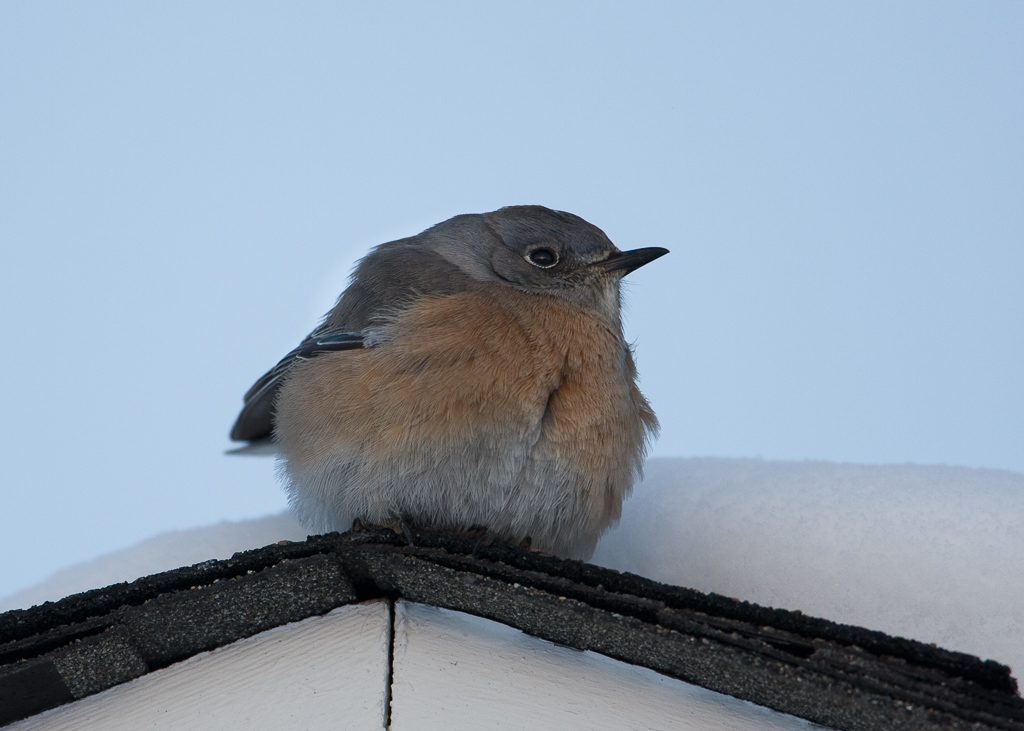
Western Bluebird puffed up to try to stay warm with it’s food source covered in snow and ice. Photo by Dennis Plank
I had nothing for them. I even tried putting out raisins, as robins
will eat raisins, and while bluebirds aren’t robins, they are…or
were..considered thrushes. They ignored them.
The snow hung around for three weeks, with the heaviest snowfall and
the ice at the very end. The Pineapple Express came early and was very
welcome. The weather broke and the snow began to melt. I found dead
bluebirds, huddled in little pathetic bundles in the lee of the
garage. I found a total of 6. It broke my heart. Their keels felt like
knife edges under my thumb. The birds had no fat on them whatsoever.
They’d literally starved.
Just another reason for me to hate snow.
It seemed that that winter had killed every bluebird in the area, for
I saw none for several years. Then, one fine morning in 2011, a mated
pair showed up in my front yard. They set up housekeeping in the same
box as my original pair. They successfully raised a brood and were on
brood #2 when disaster struck.
My neighbors at the time (thankfully, they’re gone) allowed their
dogs and cats to roam. They refused to obey the RCW that says it’s
illegal to let your cats roam. Animal Services does not enforce it,
nor does the Sheriff.
I saw one of their cats kill the male bluebird. I swear, if I’d had a
gun handy I would have shot it. I was devastated. And worried…now
the adult female bluebird had babies needing feeding and no male to
help.
I’m not certain why I thought of it, or where I read it, but I learned
that folks back East feed their Eastern Bluebirds live mealworms. I
found a place in Tumwater (Fluffy and Floyd’s, a most excellent pet
food store*) that, at the time, sold live mealworms. I bought two
dozen. Would the birds eat them? Even recognize them as edible?
I put a bowl of mealworms directly beneath the opening to the nest box.
The adult female bluebird ignored it. She made several trips to the
box but didn’t look twice at the bowl.
My heart sank.
Then, salvation, in the form of one of her juvenile daughters from her
first brood entered the box. In a few moments, she poked her head out.
She looked down at the bowl. She flew out of the box to its roof and
cocked her head, focusing her attention on the worm bowl.
She dropped down to land next to the bowl. She watched it warily for
several moment, making sure it didn’t attack her. Then she hopped
onto the rim, looking intently at the crawling mealworms at its
bottom. She thought, aha! They move! She hopped into the bowl, ate a
worm, then another. Then she began to ferry the rest of the worms to
her siblings in the box!
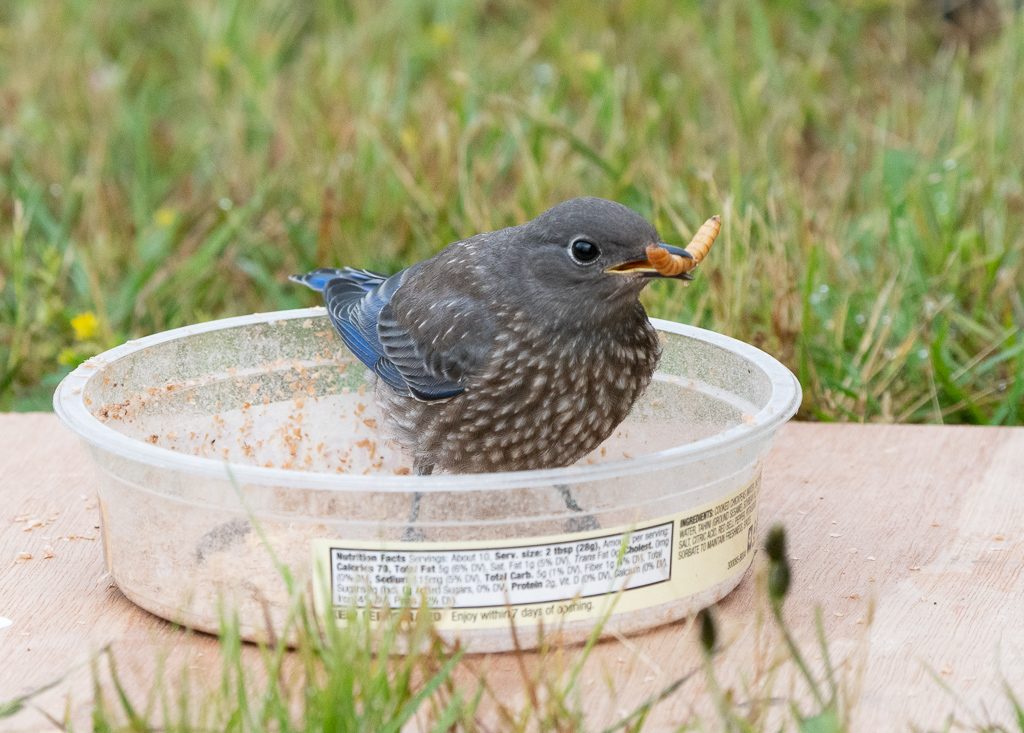
Juvenile Bluebird retrieving mealworms. Photo by Dennis Plank
I was indoors, so she didn’t hear my shouts of joy.
Bluebirds are a ‘helper’ species. It is not unusual for the older
hatchlings help feed their younger siblings. In addition, they’re far
more willing to try new foods, ones their parents ignore.
While the adult and the juvenile were gone, I hurried out and dumped
every mealworm I had into the bowl and watched the juvenile feed them
all to her siblings. The next day I bought a LOT more. The juvenile
taught her mother to eat the worms. Even better, several days later,
an adult male bluebird showed up. The mother had found another mate!!
Now, my husband and I feed the bluebirds mealworms starting the moment
we see them hunting boxes in the spring.
Through trial and error, we’ve learned that the best worm ‘bowl’ is a
flat bottomed one, with sides high enough that the worms can’t crawl
out of it. In case of possible rain, we’ll put it under a covered
storage shed so that the rain doesn’t drown the worms.
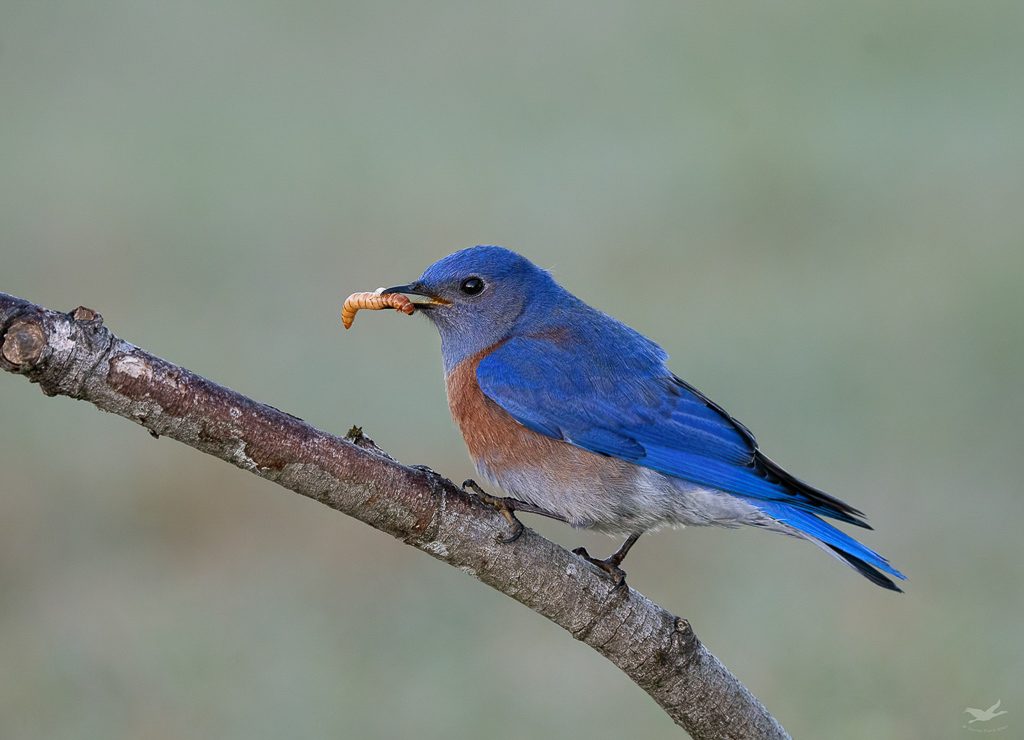
Male carrying a mealworm to a convenient perch we’ve set up. Photo by Dennis Plank
We’ve trained them to come to a specific cue. We make a kissing sound
as we’re walking out with the worms. The bluebirds have trained US as
well. They’ll swirl around our heads if we’re outside or chitter when
they hear us on our porch. The males-for we have several pairs,
now-perch in our backyard and say “chuckchuck’. They’ll wait as we,
kissing ’til our cheeks hurt, place the worm filled bowl on the
ground. We’ll back off…not too far, and they’ll land. When they have
babies, the male, especially will take the worms to the box rather
than eat them.
We’ve watched as the male of the pair will encourage a fledgling to
land on or in the bowl, where he feeds it a worm. The babies don’t
take long to figure it out!
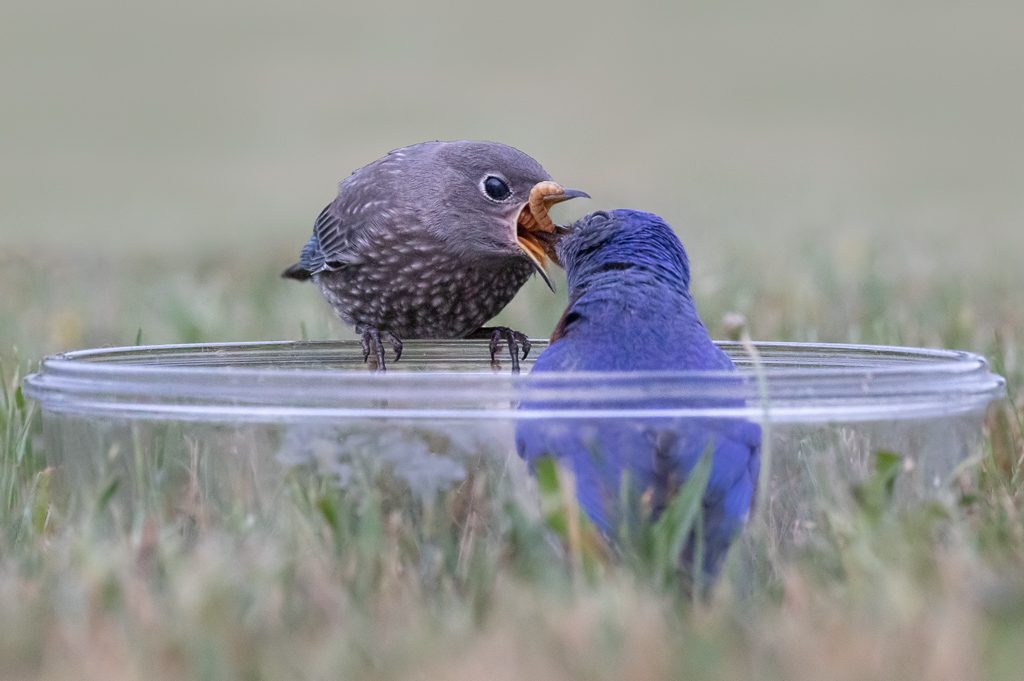
Male Bluebird feeding a youngster in a bowl we used to use. Photo by Dennis Plank
They’ve given us so much enjoyment, not to mention the opportunity for
my photographer husband to get some really great shots.
In the past, once they’ve all fledged, we’ve stopped feeding them. But
this is a La Nina year, and I bet my boots we’re going to have a heavy
snowfall. So we’ll be feeding them mealworms throughout the year.
Tonight, (it’s mid October) I placed the bowl filled with mealworms in
its usual spot. It’s actually a Tupperware box, much larger than the
original glass cake pan we’d used. I had to buy a larger container to
accommodate the crowd we have now. This evening, I watched as 11
bluebirds came to the new container and cleaned up the worms. Even as
often as I’ve seen it, it still thrills me. I’m not worried about snow
this year. When the snow demons hit us, I won’t let the bluebirds go
hungry.
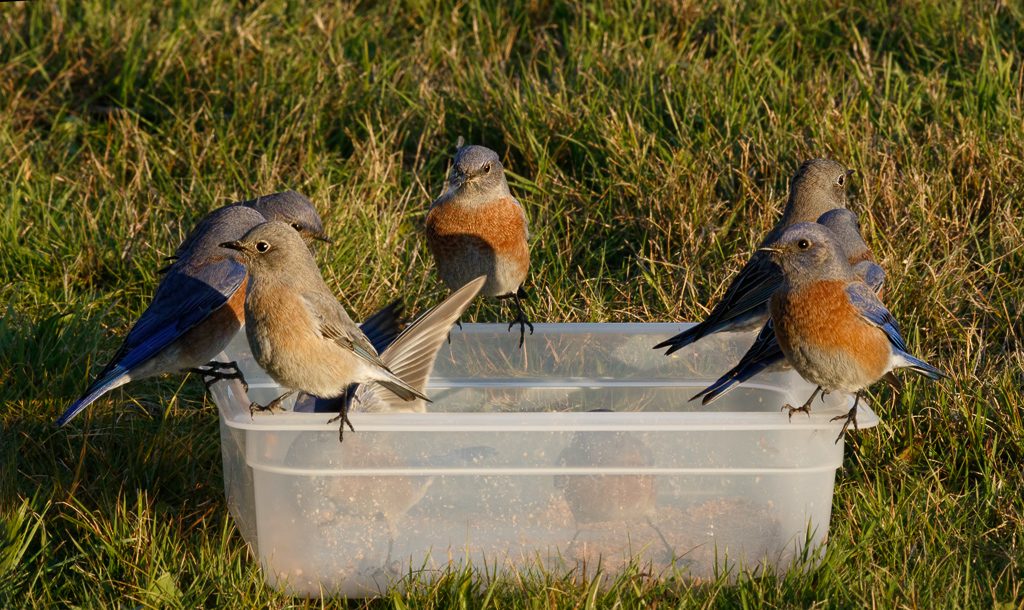
One of the mobs from this year feeding. We believe there are at least two groups coming this year. Photo by Dennis Plank
* Fluffy and Floyd’s no longer sells live mealworms. But the Pet
Works in downtown Olympia,(right next door to the artesian well)
sells several types of live worms.


A beautifully written article with outstanding photographs.
Your experience is invaluable and so could you share a little more:
1) approximately, what would be a good feeding rate of meal worms per day per bird?
2) how long will meal worms stay alive, and how easy is it to maintain them?
3) have you ever considered breeding your own meal worms?
Thanks so much; as a repeat contributor to the blog, I always look for your posts. I learn so much in a very compelling read!